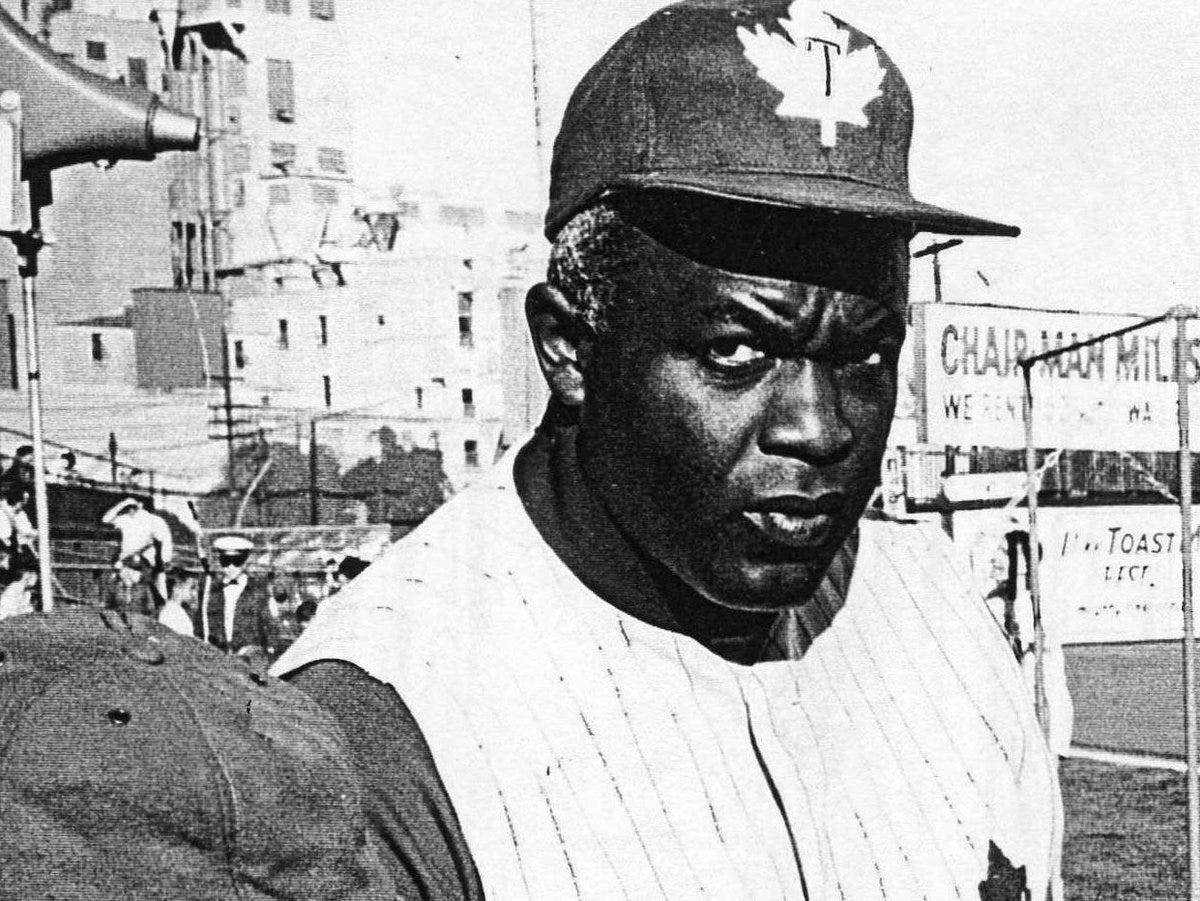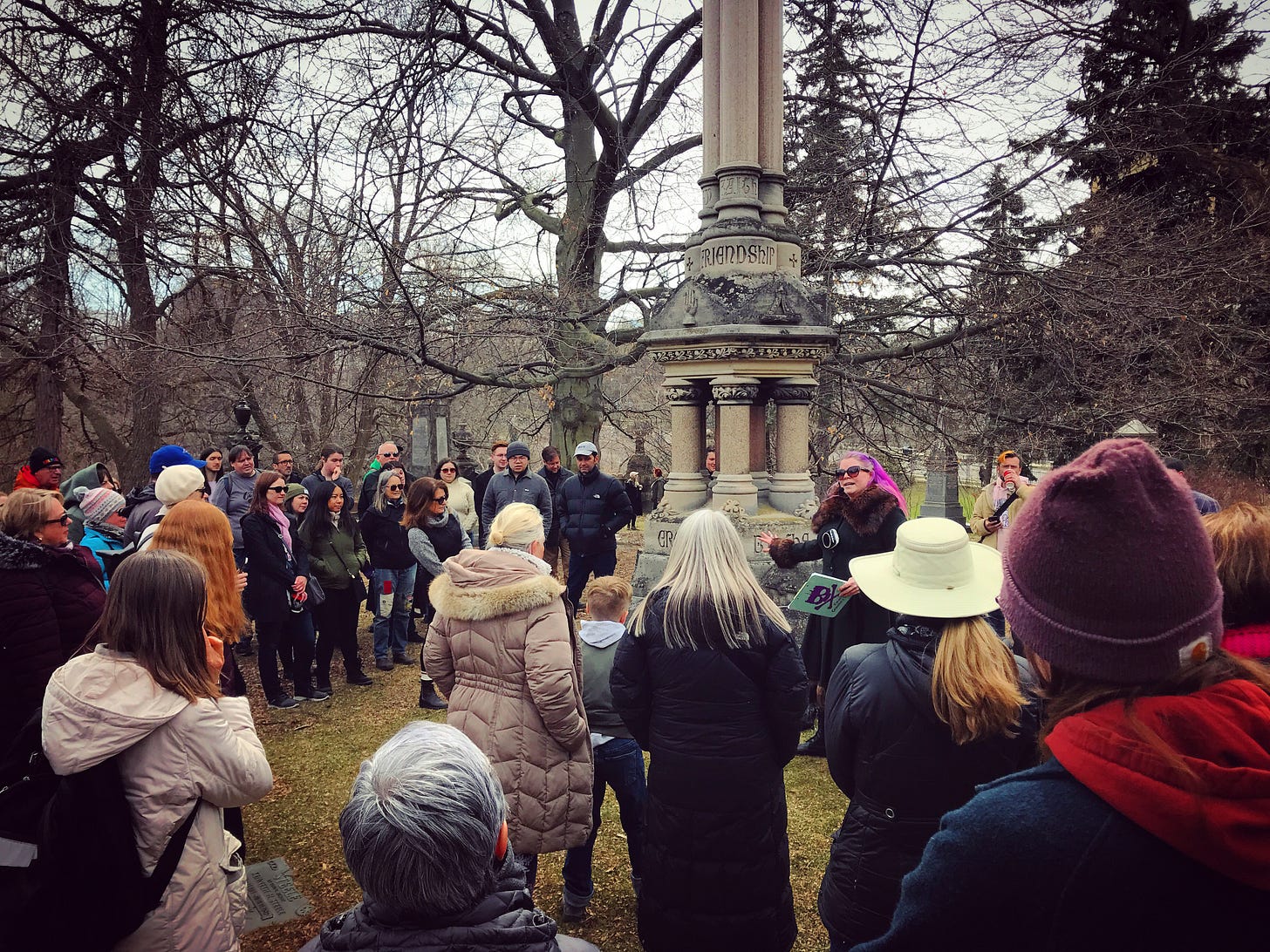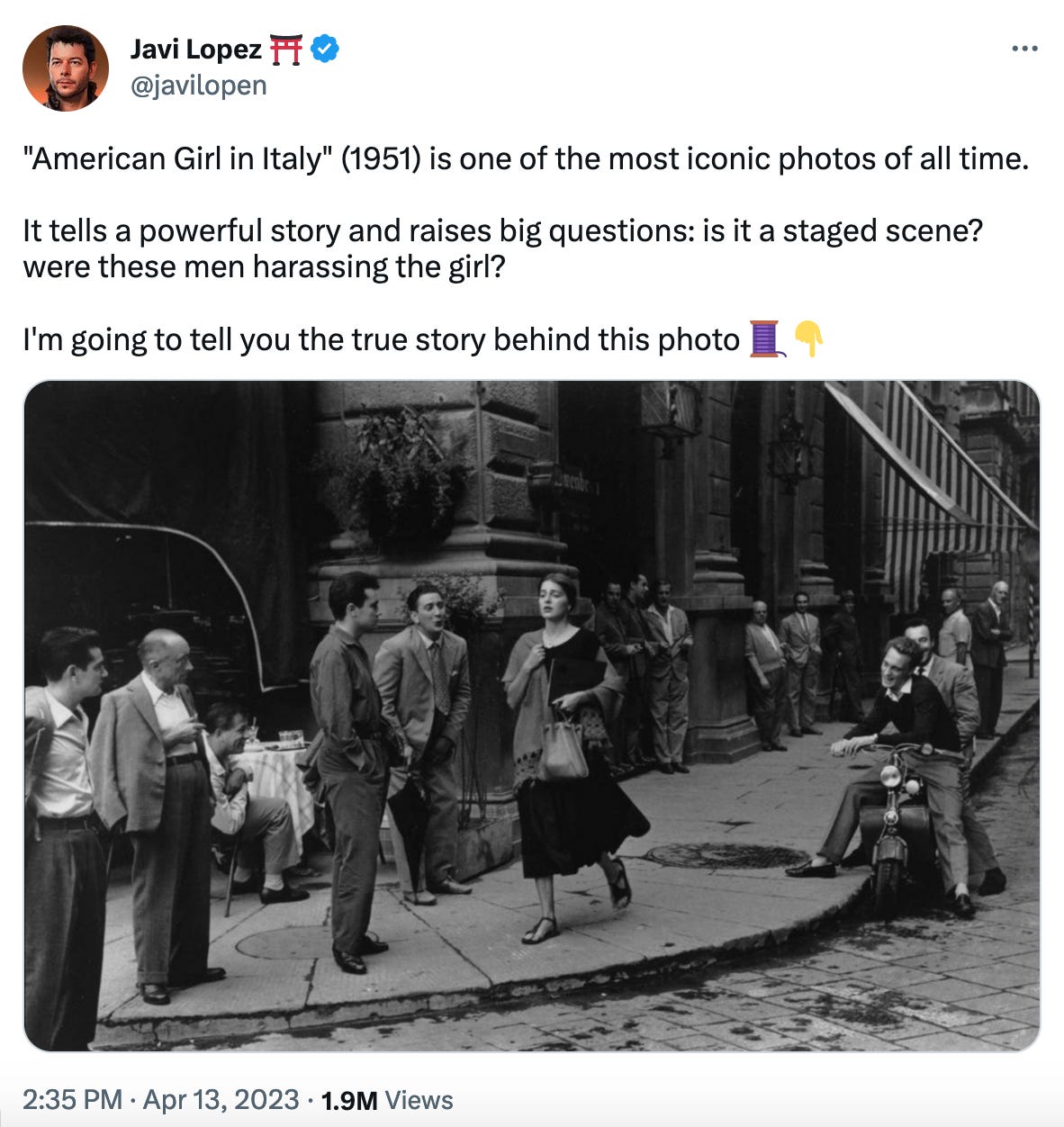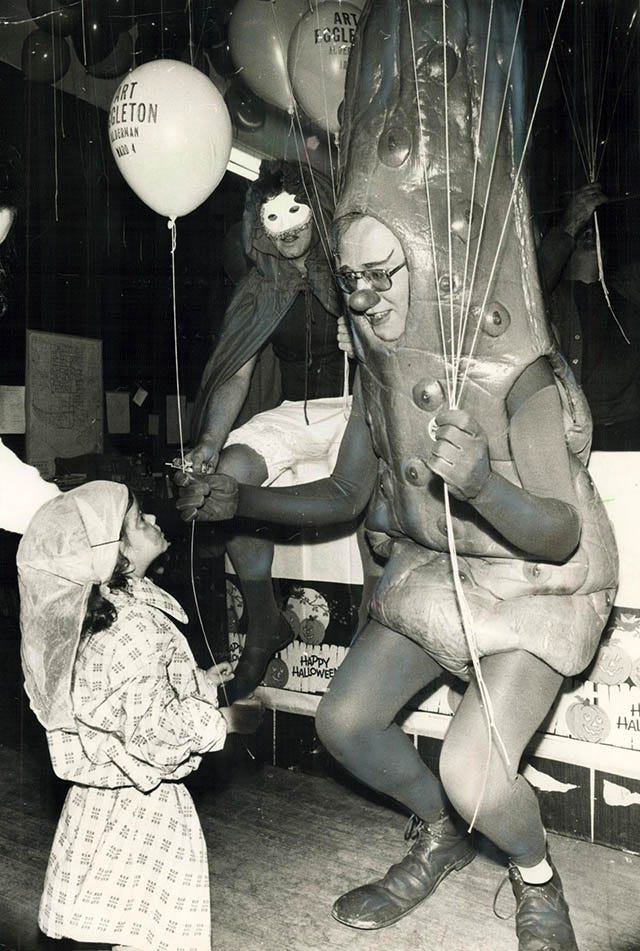How Toronto Helped Create Baseball's Colour Barrier
Plus a Torontonian begins a history hunger strike, and more...

The story begins in 1887. The Toronto Baseball Club was fighting for the pennant that season, playing at the city's first ballpark. Sunlight Park stood on Queen Street overlooking the Don Valley. The stadium had opened the previous spring with a celebratory speech from the Lieutenant Governor. And as that speech made clear, race was an issue at Sunlight Park right from the very beginning:
“It always pleased him,” The Globe reported, “to see the delight [with] which all classes of Anglo Saxons entered into athletics of every kind. This was a spirit which ought to be fostered, for there was no doubt that it had a great deal to do with the manly, sturdy characteristics which distinguished the race.”
Toronto played in the International League — one of the big minor leagues, with teams on both sides of the border. (It’s still around today; it’s the league where the Blue Jays’ AAA affiliate, the Buffalo Bisons, play.) In 1887, there were eight Black players in the league. And they all faced brutal racism.
Buffalo's second baseman Frank Grant has been called "the greatest player of his age," but his own teammates once refused to take their team photo with him. Opposing pitchers made a habit of throwing at his head.
Binghamton infielder Bud Fowler wore wooden shin guards to protect against the players who tried to drive their spikes into his flesh as they slid into his base. His teammates were fined for refusing to play with him.
When Newark hosted the National League's Chicago White Stockings for an exhibition game, Chicago's future Hall of Famer Cap Anson put up a stink. He refused to play unless Newark benched Moses Fleetwood Walker, who'd been among the first Black players to play in the Majors.
And when the Syracuse Stars came to Toronto, they lost the game on purpose because their pitcher was Black, giving up 21 unearned runs in an attempt to embarrass him. Even The Toronto World — a newspaper that was often racist in its own right — called it "DISGRACEFUL BASEBALL."
But Toronto is said to have been worst of all. Nowhere did the league's Black players face more abuse than at Sunlight Park. As baseball historian Jerry Malloy put it a century later, "The most vociferous opposition to integrated baseball came from Toronto.”
The Toronto Baseball Club had no Black players. And they never would. But that didn't stop them from having a Black "mascot." A boy named Willie Hume travelled with the team as a "lucky charm" for a while — a disturbingly common practice back then.
It didn't end there. When opposing teams fielded Black players, the Toronto fans let loose with their bigotry. During a game against Buffalo that summer, the crowd blew their horns and released a torrent of hatred, shouting “Kill the [n-word]!” And during that very same month, Toronto would play a leading role in banning Black players entirely.
On the same day Cap Anson refused to play against Moses Fleetwood Walker, the International League held a meeting at a hotel in Buffalo. The teams took a vote. It would decide whether to outlaw the signing of any more Black players. Toronto voted in favour and the racists won. The ban was adopted by a vote of 6–4. The colour line was drawn. And Toronto helped draw it.
The Toronto Baseball Club went on to win the pennant that year thanks to star players like the notorious alcoholic monkey-owner Cannonball Crane and con artist catcher Harry Decker. But our city's first baseball championship will always be tainted by the racism that accompanied it. And when a few other teams tried to overturn the ban that offseason — during a meeting held in Toronto at the Rossin House Hotel on King Street — the Toronto Baseball Club helped kill the idea. The racist policy would remain in place.
The International League ban has been cited as the turning point in baseball's bigotry. The Major Leagues quickly followed suit with an unspoken "gentlemen's agreement" to ban Black players. It would last 60 years.
It wasn't until 1946 that another Black player would join the International League. It was Jackie Robinson, playing for the Montreal Royals as he prepared to break the Major League colour barrier the very next year.
If you'd like to learn more about Black players in the International League, Jerry Malloy's 1983 article “Out at Home” was a vital source for this piece and where I first learned about Toronto’s role in the creation of the colour barrier. You can read it here.
Just a very quick reminder that you can support all my work by becoming a paid subscriber to The Toronto History Weekly. Fewer than 5% of readers have made the switch so far, which basically means that by offering a few dollars a month you’ll be giving the gift of Toronto history to 20 other people. You can make the switch by clicking here:
A BIZARRE THANK YOU!
The Festival of Bizarre Toronto History came to an end a week ago today. And I want to thank everything who played a part in it — from all the wonderful people who tuned in on Zoom or made it out in person for our walking tours, to the fascinating speakers and tour leaders who shared their stories with us, to Henderson Brewing who hosted our wrap party and offering some free pints. It was an incredible privilege to get to spend the week with you all — and a bigger success than I ever imagined. I can’t wait to bring the festival back in 2024!
THE NIAGARA HUNGER STRIKE
Last week, a 76-year-old man from Toronto chained himself to a historical plaque at the “Negro Burial Ground” in Niagara-On-The-Lake and began a hunger strike. James Russell is demanding that the local government restores nineteen gravestones that have been neglected and are buried on the site. The headstones belong to Black settlers who lived in Niagara in the early 1800s, among twenty-eight graves that were discovered there with ground-penetrating radar last year. The restoration is expected to $59,000 and Russell is determined to pressure the government to act quickly to bring the stones back to the surface and preserve this piece of the history Niagara’s Black settlers for future generations.
QUICK LINKS
The best of everything else that’s new in Toronto’s past…
ELON MUSK’S FRAGILE EGO NEWS — As you may have heard, petty billionaire (and unlikely Canadian citizen) Elon Musk seems determined to use one of the world’s most vital social media platforms as a way to seek vengeance for his own personal grievances. And one of his latest tantrums means there will be a little change to our Quick Links section going forward. Musk has banned tweets from being embedded in Substack newsletters. That was one of the most frequent ways I shared Toronto history news here, so it’s a pain. But I’d like to keep the dash of visual interest those embedded tweets provided, so for now I’ll try manually recreating it by including screencaps of tweets when I can. We’ll see how it goes!
ICONIC PHOTO WITH A SURPRISING TORONTO CONNECTION NEWS — On Twitter, Javi Lopez shared the story behind the famous 1951 photo “American Girl in Italy.” And it turns out to be a photo of a Torontonian! Read the full thread.
PATTY VICTORY NEWS — One of the highlights of The Festival of Bizarre Toronto History was getting to spend a night chatting about the Patty Wars with Chris Strikes and Michael Davidson. When federal inspectors threatened to drive our city’s Jamaican patty vendors out of business in 1985, it was Michael Davidson who led the charge to save them. He’s the focus of Chris Strikes’ wonderful short documentary about the Patty Wars, Patty Vs. Patty — a film which has now just taken home a Canadian Screen Award! Watch the documentary.
MAYORAL PICKLE NEWS — We also had a lot of fun on the festival’s Thursday night, talking about some of the strangest photos in Toronto history. Local history writer extraordinaire Jamie Bradburn was kind enough to join us. And he’s now written up the story behind one of picks on his Tales of Toronto site: a photo of future mayor Art Eggleton dressed as a pickle. Read more
TRAVEL BACK 81 YEARS NEWS — On Twitter, Morgan Cameron-Ross shares some mundane yet extraordinary footage of Bay Street during the Second World War. Watch it.
MYSTERIOUS SHACK NEWS — Jack Landau shares the story behind “a curious abandoned shack in a Toronto strip mall parking lot.” Read more.
TORONTO HISTORY EVENTS
TEN OF TORONTO: WHAT DO TEN NEIGHBOURHOODS TELL US ABOUT WHO WE ARE?
Until April 30 — Myseum — 401 Richmond Street West
“Toronto is vast and diverse in people, places, and experiences. With 2.8 million of us who call this dynamic city home, we explore what it means to call Toronto a ‘city of neighbourhoods’ through the lens of 10 distinct communities and themes. In Ten of Toronto, we reflect on our shared histories by looking at the forces that have shaped the city’s neighbourhoods: geography, economy, immigration, finance, urban development, culture, inequality, and social values. Join us, steal away, and stay awhile. We invite you to discover your own path through the stories and histories we’ve unearthed for this exhibit, and lend your voice – what do neighborhoods mean to you?”
Free!
I TURN MY CAMERA ON: TORONTO ALT-ROCK IN THE 1980s
Until April 30 — The Local — 396 Roncesvalles
West end bar The Local will be displaying photographs taken by Jeremy Gilbert during the golden age of Toronto alt rock.
Free presumably!
CLOSE LOOKING: THE SHADOW OF THE YEAR WITH POEMS BY FLORENCE WYLE AND WOOD ENGRAVINGS BY ROSEMARY KILBOURN
April 17 — 11am — Online — AGO
“Join Erin Rutherford, Collection Development Librarian, as she discusses The Shadow of the Year (1976) with poems by Florence Wyle and wood engravings by Rosemary Kilbourn from the Collection of the E. P. Taylor Library and Archives. This short talk will explain why the Library holds multiple copies of the title, compare them, and highlight their differences. Which private press published the book? At which Toronto gallery did the book launch? Does an envelope tucked into one copy reveal a connection to a third Canadian artist? Celebrate the coming of Spring through a study of beautiful books and a reading of Wyle’s calming words.”
Free!
NATE HENDLEY ON THE BEATLE BANDIT
April 19 — 6:30pm — North York Central Library (Room 1)
“Matthew Kerry Smith was a troubled navy veteran who robbed Toronto-area banks in the early 1960s to finance a one-man revolution. On July 24, 1964, disguised in a Halloween mask and a ‘Beatle’ wig, Smith held up a bank at Bathurst Manor Plaza in North York, Ontario. Smith killed a patron who tried to intervene, then escaped. Dubbed ‘The Beatle Bandit’ by the media, Smith's actions fueled a nationwide debate about gun control, insanity pleas, and the death penalty.”
Free!
LINDSAY ZIER-VOGEL: LETTER TO AMELIA
April 20 — 2pm — Brentwood Library (Program Room)
“Toronto-based author and letter writer Lindsay Zier-Vogel discusses Letters to Amelia, her debut novel inspired by her passion for Amelia Earhart, and the power of reading and writing letters for both connection and self-discovery.”
Free!
BLACK HISTORY IN ONTARIO: ONLINE SERIES
This is a series of three free online talks hosted by the Toronto Branch of the Ontario Genealogical Society, each one beginning at 7:30pm. The first has already been held, but there are two more still come:
THE SEARCH FOR ALFRED LAFFERTY, BLACK EDUCATOR AND LAWYER (April 20)
“In 1869 Alfred M. Lafferty, M.A., Richmond Hill, was a witness to the marriage of William Denis Lafferty, a black farmer who lived in Etobicoke. Who was the man with the same surname and a university degree? Hilary J. Dawson’s research uncovered the story of the Lafferty family, and the successes, challenges, and tragedies they faced. The Lafferty parents arrived from the United States in the 1830s as freedom-seekers. They were illiterate and penniless, yet gave their children the best education they could afford. Alfred Lafferty won prizes for excellence at both Upper Canada College and the University of Toronto. He would become the first Canadian-born black lawyer in Ontario. This presentation will show the resources Hilary used to develop a picture of the Lafferty family.”
BLACK HISTORY IN ONTARIO, 1793–1965 (April 27)
“Winston Anderson will be presenting a timeline of events from the passing of the Act To Limit Slavery in 1793 by Lieutenant-Governor John Graves Simcoe, to 1965 when MPP Leonard Braithwaite pushed for the Separate Schools clause on segregated schools for Blacks to be officially removed from the provincial education policy. He will be discussing a number of people of Black heritage, both free and enslaved people, who shaped Toronto.”
Free!
STREETCARS AND THE SHIFTING GEOGRAPHIES OF TORONTO
April 20 — 8:30pm — Online — The Toronto Railway Museum
“What can photos taken by streetcar enthusiasts reveal about the changing nature of cities? This is the question explored by Brian and Michael Doucet in their book Streetcars and the Shifting Geographies of Toronto: a visual analysis of change. The Doucets carefully and meticulously rephotograph these images taken in the 1960s and 70s to bring them into dialogue with contemporary planning, policy, political and public debates.”
BATTLE OF YORK SUNDAY: THE 210th ANNIVERSARY
April 23 — 11am to 4pm — Fort York
“This one-day event at Fort York National Historic Site commemorates the 210th anniversary of the Battle of York and examines this fundamental moment in Toronto history to engage visitors with stories of the battle and its impact on this land and its peoples. The day will include a special Battle of York tour, titled ‘The Anishinaabeg Defenders of York: Battlefield Tour’, as well as historic weaponry demonstrations, historic kitchen animations and more.”
Free!
THE DON: INMATES, GUARDS, GOVERNORS AND THE GALLOWS
April 26 — 7pm — Northern District Library (Room 224)
“Join writer and researcher Lorna Poplak as she presents facts behind the Don Jail's location and construction and shares tales about inmates, guards, governors, gangs, officials and even a pair of star-crossed lovers whose doomed romance unfolded in the shadow of the gallows. The illustrated talk will highlight the Don's tumultuous descent from palace to hellhole, its shuttering and lapse into decay, and its astonishing modern-day metamorphosis.”
Free!
ERNEST HEMINGWAY IN TORONTO
April 27 — 2pm — Brentwood Library
“Ernest Hemingway lived in Toronto during 1923 while he worked for the Toronto Star newspaper. He had moved to the city from France with his pregnant wife Hadley, as she preferred to give birth in North America. Their son, John Hadley Nicanor Hemingway, was born at Wellesley Hospital, in Toronto, on October 10, 1923. This special centennial presentation considers the role the area played in Hemingway's apprenticeship as a writer, and in his personal life.”
Free!
USING TORONTO’S ASSESSMENT RECORDS IN YOUR RESEARCH
May 4 — West Toronto Junction Historical Society
This is part two of a series about researching the history of your house, presented by Jane MacNamara of the Ontario Genealogical Society.
MASS CAPTURE: CHINESE HEAD TAX AND THE MAKING OF NON-CITIZENS
May 8 — 7pm — Toronto Reference Library (Beeton Hall)
“Professor Lily Cho joins us to discuss her award-winning book, Mass Capture: Chinese Head Tax and the Making of Non-citizens. Through extensive archival research on C.I.9 certificates, Canada's first mass use of photo identification, the book delves deep into the history of surveillance and exclusion against Chinese migrants in the country.”
Free!
AFRICAN-CANADIANS IN THE U.S. CIVIL WAR: EXPLORED THROUGH HISTORY AND POETRY
May 12 — 6:30pm — North York Central Library (Auditorium)
“This year is the 160th anniversary of Black troops entering the Union Army. Join the Society and Recreation department for a discussion about African-Canadians and their journey crossing the border and their contributions in the war against slavery. No registration required.”
Free!
GOOD AND EVIL: THE TRUE STORY OF CANADA’S FIRST HANGMAN
May 15 — 7pm — Riverdale Library
“Author Julie Burtinshaw will present her biography of John Radclive, Hangman: The True Story of Canada's First Official Executioner. She will discuss the research and writing process, Radclive's personal and professional life and the questions the story raises about Canadian attitudes towards capital punishment.”
Free!
&
HANGMAN: THE TRUE STORY OF CANADA’S OFFICIAL EXECUTIONER
May 16 — 7pm — Queen/Salter Library
“Author Julie Burtinshaw will present her biography of John Radclive, Hangman: The True Story of Canada's First Official Executioner. She will discuss the research and writing process, Radclive's personal and professional life and the questions the story raises about Canadian attitudes towards capital punishment.”
Free!






